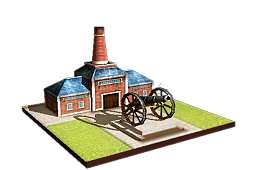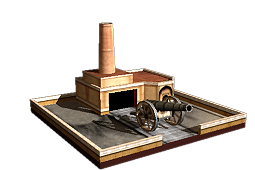Cannon Foundry (ETW building)
| Cannon Foundry | |||||||
|---|---|---|---|---|---|---|---|
| Category: | Ordnance | ||||||
| Level: | 0 | ||||||
| Turns to build: | 3 | ||||||
| Building cost: | 750 | ||||||
| |||||||
| Enables | |||||||
| Ordnance Factory | |||||||
Cannon foundries not only make guns, but also ammunition and the associated equipment for artillerymen. They are hot, dangerous places to work.
The casting of early cannons is more of an art than a science, and few of the weapons produced are standardised pieces. This is the result of casting limitations, the quality of iron or bronze available, and the manufacturing process (cannon casting was an adaptation of bell making). Most 6-pounders would be around the right calibre, but no two were truly identical. It was enough that the cannon did not burst and kill its crew, and hurled a shot in the general direction of the enemy.
Cannon foundries are also responsible for making the ball shot used by the weapons, but not the powder. No one but a raving lunatic would make gunpowder anywhere near a foundry, with the risk of stray sparks and consequent catastrophe! That said, making guns, like any casting work, is a dangerous business: if the sand moulds are even slightly damp then a steam explosion can occur. Anyone nearby is likely to be killed or maimed by hot metal and pieces of the mould.
In 1716, an explosion at the English foundry in Moorfields killed and injured many people when metal was poured into a damp mould. Among those hurt were Colonel Armstrong, the Surveyor-General of Ordnance. The foundry itself was totally destroyed.



